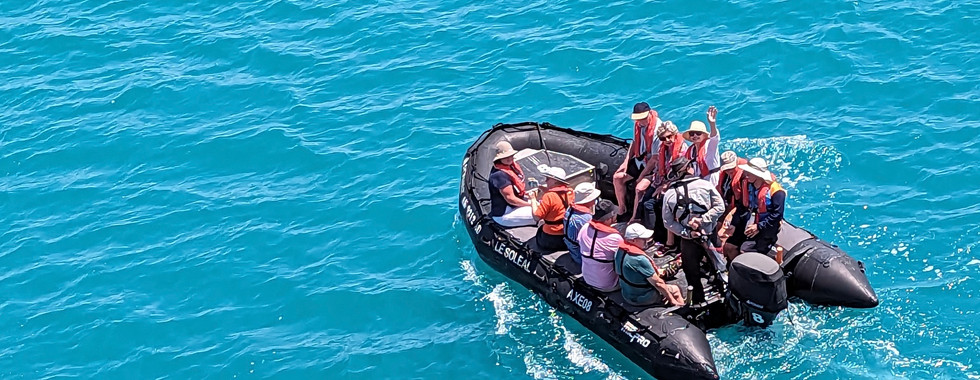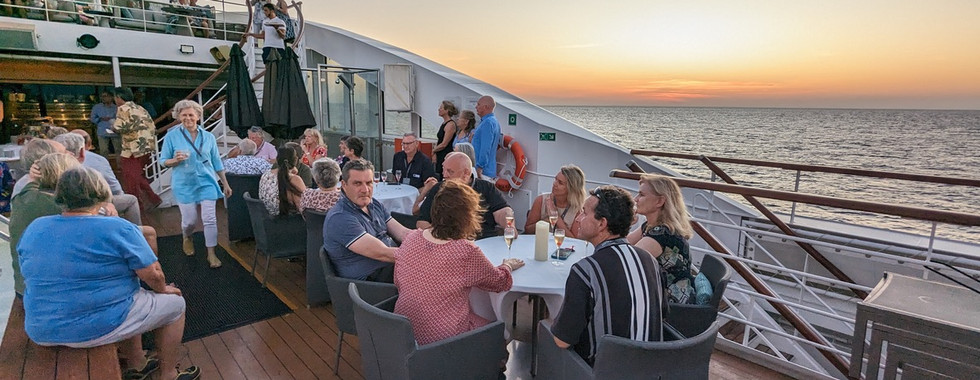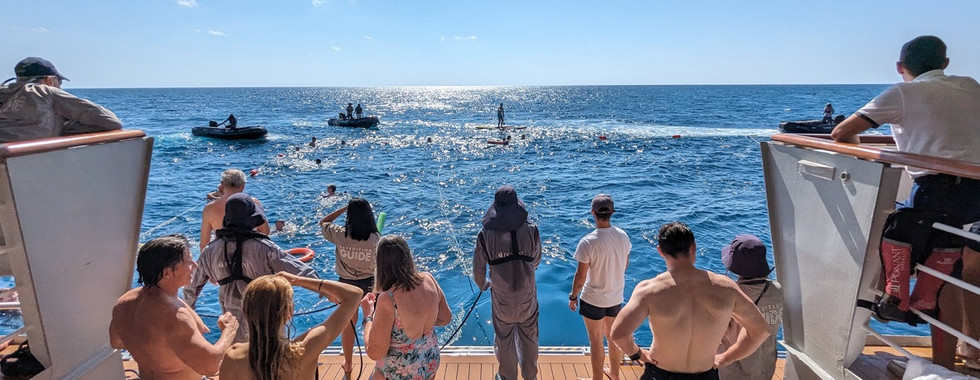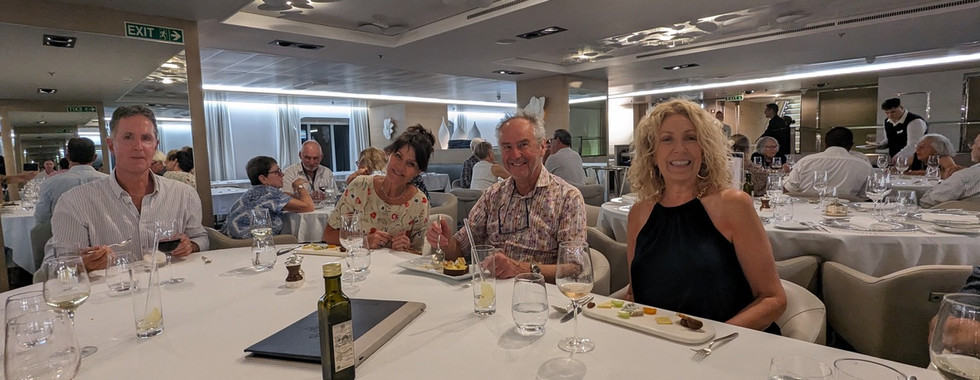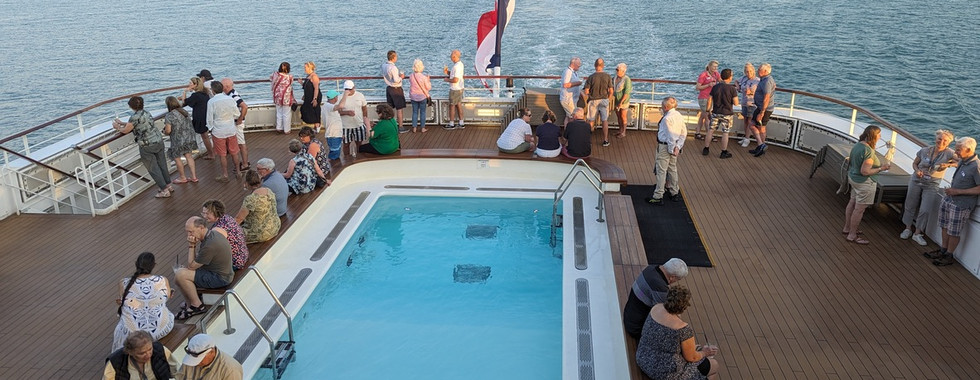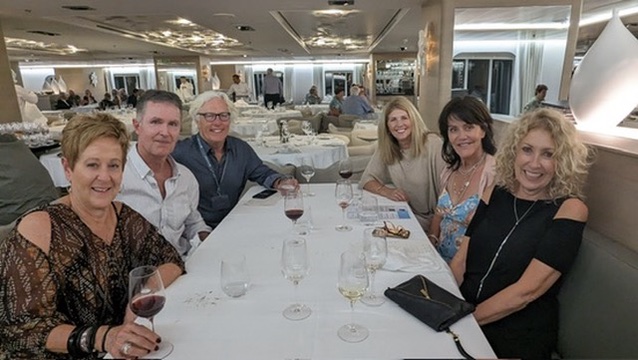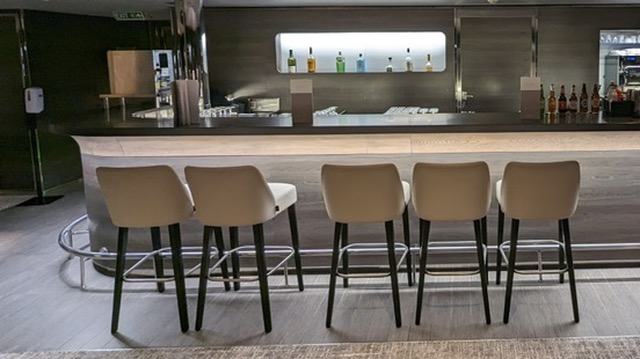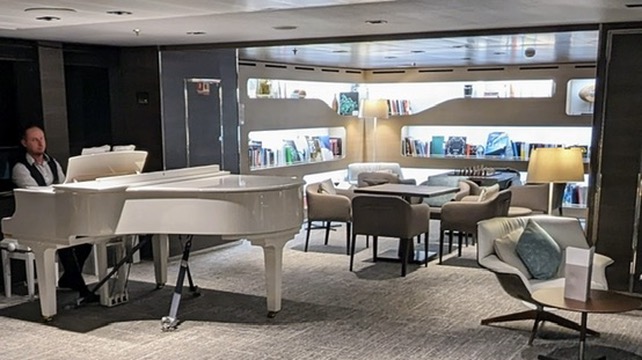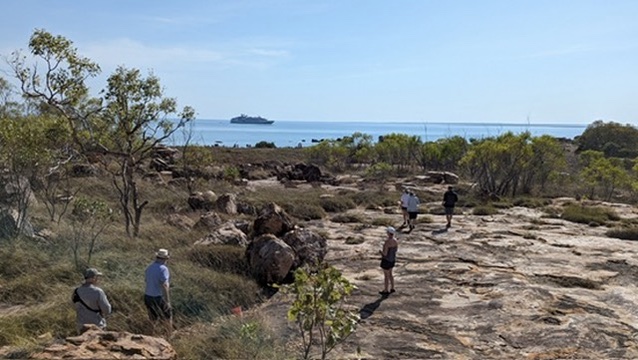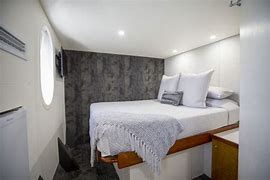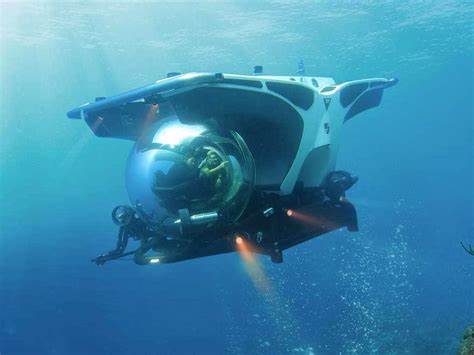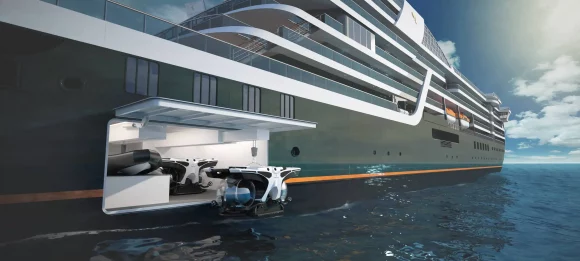
Australia's Kimberley Region - like nowhere else on earth.
Period.
Ah, the majestic, fantastical Kimberley, where the ochre-red cliffs of the desert plummet into the turquoise-hued waters of an exotic sea and thirsty rivers, a mystical union unfolds—a symphony of earth and water, whispered secrets carried by coastal breezes and sun-kissed beaches that guard ancient stories of the Dreamtime.

This is my personal guide to help you unlock the wonders this region has hidden away. The recommendations below are based on my own experiences and designed to help you plan your own Ultimate Kimberley Adventure. I also share insider secrets that you won't find anywhere else on how to secure the best prices. This is a big guide because this is a big region and an even grander adventure. You can't afford to stuff it up.
Why not join me on my next Hosted Expedition to the Kimberley in 2025?
Please contact me with any questions about the region or expedition cruising.
6-Star cruises @ 3-Star Prices
Fleet Captain James Hardy
Text 0430 200 535 - james@kvi.travel
In this guide, you will learn the following - use this menu to click ahead at any time.
When to go
Tour a 6-star suite
Facebook group - Tips - Advice - Hotel suggestions - Trip Planning

If a Kimberley cruise isn't on your bucket list .... Shame on you, it should be.
But even if the Kimberley is but a distant dream, remember to return to FAB when ready.
We will always find you the cheapest possible deal on the world's best 6-star ships.
That's a guarantee you can take to the bank - along with all the lovely bubbly money we will save you.
Everyone at Team FAB is an expert in Expedition Voyages, and, more importantly, no one in the industry knows the discounting cycles better than us.
Why the Kimberley
No place on earth comes close to this region's ancient, rugged beauty, exotic wildlife, and unique landscapes. Wake each day to an array of wonders that will leave you in a perpetual state of awe that will be etched into your soul forever. If that sounds hyperbolic, 'do your own research' and ask anyone who has been.
Welcome to the Kimberley region, a land carved over millions of years by the powerful forces of wind, rain, and tidal flows.
But what is it that truly sets the Kimberley apart?
Most have but a vague notion of that remote and blank expanse on maps of Australia's westernmost point, but what does it encompass? What makes an expedition cruise to this legendary land stand out from all other cruises?
If you take nothing else away from this guide, pause to watch any of these short reels, and you'll begin to grasp the distinction. They encapsulate what lies in store for you better than my clumsy words ever could or even those of a learned scholar.
To be brutally honest with you, when I cruised the Kimberley last season, I had no idea what to expect. In hindsight, I am ashamed to admit that my narrow, perceived ideas had me go in prepared for a lot of red dirt, blue water, and not much more. I could not have been more wrong. This cruise, more than any other, changed my life and my perspective on life.
The Kimberley is an untamed wilderness, the likes of which you will have never seen before. You will hear that a lot because it's true.
Those fortunate enough to experience the Kimberley come away surprised at the deepness of the intimate connection they invariably forge with the world that has barely changed since prehistoric times.
All who visit learn very quickly that their every move is watched over by ever-vigilant crocodiles who have remained remarkably consistent in their form and behavior over the course of millions of years. Their lineage traces back to the Mesozoic Era when dinosaurs roamed the Earth. Not much has changed here in eons, and these ever-ubiquitous Crocs prove that the old adage is undoubtedly correct: why change if you don't have to?
I guarantee you this: your Kimberley Expedition will undoubtedly be one of your life's great adventures. It most certainly is not just another cruise. It will transcend mere travel and become a tonic for your soul.

There are two Kimberleys
Depending on whether you venture by road or sea, there are effectively two distinct Kimberley experiences. It is essential to understand that there is almost no way to access the coast on the road between Darwin and Broome. If you want to see her most spectacular crown jewels, you need a ship. And not just any ship.
Those who claim to know the Kimberley having visited only by road are in for some surprise.
Understanding the need for protection and how this will impact your experience
As this unique ecosystem is so pristine and has remained unchanged for millennia, traditional owners and successive governments have instituted ever-increasing restrictions on the tourism industry. Although these protections need to be applauded, understanding these dynamics will help provide context to current itineraries, how these may change in future years, and, ultimately, what you will end up paying for your fare.
Perhaps the most critical restriction on operators is a cap on the size of vessels permitted to cruise coastal waters, rivers, and anchorages. As with the limited access by road, there is also a complete lack of coastal towns or ports. This means that only ultra-small vessels are viable, mostly no larger than 200 people. Finally, traditional cruise ship tenders are unusable for going ashore without docking infrastructure.
This is why you will never see larger mid-range operators advertising Kimberley Itineraries. Even if they could get permission, which they won't, they cannot conduct beach landings, which is the only way to get passengers ashore.
Occasionally, you may see a line like Princess or Cunard offering circumnavigation voyages around Australia that appear to include the Kimberley region. Just be mindful that if you book one of these larger cruise ships on the run between Darwin and Broome, you will not be able to go ashore, and the ships will be kept some considerable distance from the coast.
The only way for an operator to land passengers along the Kimberley coast is to use a fleet of zodiacs, and only custom-built expedition ships can accommodate these. Additionally, a large team of expedition leaders is required to operate such a fleet, and all of these need to be experts in different disciplines, from marine and bird life to history and geology. These expedition teams can number as many as 40 people and do not come cheap, significantly increasing operating costs. At the same time, the caps on passenger numbers mean that such costs cannot be defrayed as they can be on higher-capacity vessels.
Don't leave it too late.
Everyone, especially Australians, should have the opportunity to experience the Kimberley, which, after all, is in our own backyard. Although I'm sure everyone understands the need to preserve the natural environment, the strictness of the regulations automatically rules out mass tourism, and this is where I am conflicted. The protections and limitations detailed above mean that only those with significant financial resources can afford a Kimberley Expedition Voyage. A Kimberley Expedition cruise will be out of reach if you are slogging away at a job with minimum wages or have a family to raise.
Sadly, this situation will only worsen in subsequent years as demand increases against capacity constraints that can not be significantly improved and as ever more severe restrictions come into force. One example is that operators are now restricted from taking zodiacs or fast boats 'through' the narrow Horizontal Falls. (The good news is that the experience has not been significantly diminished .... yet.) Just be mindful that, as with climbing Ularu, what might be possible this season may change in the future.
Unlike traditional cruising, all standard excursions are included in your fare and conducted by hardy zodiacs. The diverse team of naturalists and scientists leading each excursion will deepen your understanding and appreciation of this unique ecosystem. Some ships offer sea kayaks for an additional fee, which everyone raves about, while Seabourn goes one step further and has their own 6-person submarine.
When to go
The season is relatively short from late May through late October, with the best weather between June and September. As such, voyages at either end of the season will be slightly cheaper.
Like everything in far north Australia, every single element of life swings on rain. Or the lack thereof. The Kimberley has only two seasons, The Wet and The Dry.
Once The Wet starts, the rain will continue for months without pause, making any tourism operation nonviable. Hence, why cruise ships, like migratory birds, fly off to follow the sun.
Waterfalls: Early in The Dry is the best time to view magnificent waterfalls as these will be photogenic torrents cascading down rocky cliffs. They will have less volume late in the season.

Whales: Almost as if by divine compensation, the whales come out to frolic as the water evaporates off the sun-scorched earth. They first appear in Kimberley waters, their summer breeding grounds after the frigid cold Antarctica, toward the end of May or early June, with the peak of the northern migration occurring in the last week of July.

Calving occurs in Kimberley waters between June and November, and just like us, they linger as long as they can to enjoy their summer holiday.
In a nutshell, if you want waterfalls, go early; if you'd prefer whale soup to be on the menu, go later, which is why June/July/Aug are considered peak.
The bottom line is that it doesn't matter when you go; just go.
How to get there
Almost all itenaries are ten days long, and these will run back-to-back throughout the season from either Broome or Darwin.
Broome and Darwin are both served by Qantas, Virgin, Qantaslink, and Alliance.
Darwin is a large city and an international gateway, with daily flights to and from most major capitals, Singapore, Bali, and other Asian cities.
Broome is a wee outback town, a long way from nowhere, bang in the middle of the nowhere, which is part of its charm. It is home to an equally small airport. Daily flights only operate to and from Perth in the south. Direct flights between Darwin and Broome are not usually an option.
Direct flights to Melbourne and Sydney by Qantas are only offered two to three times per week. You will always be able to find a flight out the same day you disembark, but if your destination is the West Coast, you may have to go via Perth. Therefore, staying a night or two may be more prudent and cheaper until you can get a direct flight home.
For those with extra time and the cash to splash, the Ghan from Adelaide to Darwin is worth considering to extend your once-in-a-lifetime adventure.
Itineraries
All itineraries - by the large operators will be almost identical.
You will have a choice of starting in Darwin or Broome. There is no material benefit of either one over the other.
The bottom line is that although Darwin is more convenient, with daily flights, everyone will have to plan around fewer options in Broome - (either at the start or end of your cruise). If your window of travel is limited, don't fuss about the direction of travel.
Highlights featured in almost all itineraries offered by all operators
Darwin is the smallest, wettest, most northerly, and quintessentially Australian of the mainland capital cities. She is a bit of an odd bird and reminds me of Pirate Town, with a kaleidoscope of exiles streaming in from across the globe. Scottish backpackers mingle with uber-rich Americans and drown beers with Crocodile Dundee wannabes. Everyone here is about to either head off or has just come back caked in the dust of the outback. Why do the come?
Kakadu National Park, a World Heritage-listed treasure, lies just two and a half hours from Darwin.
Litchfield National Park, a mere 90-minute drive south of Darwin, is a hidden gem in the Northern Territory. Its stunning landscapes, refreshing swimming holes, and iconic magnetic termite mounds make it a top destination for all visitors to the Top End.
Darwin has a rich history that is worth unearthing. Did you know that bombs were dropped on Darwin than on Pearl Harbour?
"Christmas Eve of 74" is etched in her DNA.
Speaking of Pearls, if these are your thing, this is home to the South Seas global headquarters of Paspaley Pearls
Finally, if you hail from overseas or are under 50, to understand Darwin's DNA, you need to learn the words to this song, Santa never made it into Darwin.
On Christmas Eve of '74
A warning sounded out
On all the broadcast stations
A great storm was near about
Boys and girls all sleeping there
Tomorrow of their day
Mums and dads all prayin'
The storm would blow away
Santa never made it into Darwin
Ancient Rock Art: Wander among the timeless galleries of Wandjina and Gwion Gwion figures—prehistoric masterpieces etched into the Kimberley's rugged cliffs.
King George River: Stand in awe before the towering Twin Falls, where water cascades from great heights, painting rainbows against the ochre rock.
Horizontal Falls: Brace yourself for an exhilarating ride on the turbulent white water caused by the narrow tidal choke points, as the massive tides of the region suck megalitres of water per minute from the inland river system that is reluctant to let go of a drop.
Montgomery Reef: Witness the miracle of emergence as this submerged reef, way out at sea, reveals itself during low tide, teeming with marine life.
Mitchell Falls: Fly low and fast across these ancient gorges to reach the multi-tiered waterfall, where pristine waters plunge into emerald pools.
Buccaneer Archipelago: Explore a labyrinth of hidden coves, secret beaches, and rugged islands—a sailor's dream come true.
Ashmore Reef: A sanctuary for seabirds, marine turtles, and other diverse marine species If conditions permit you may be lucky to experience an ocean swim.
Broome: Along its Indian Ocean coastline, the white sands of 22km-long Cable Beach offer a dramatic backdrop for sunset camel rides. At Gantheaume Point nearby, dinosaur tracks are revealed in the beach’s red rocks during low tide.
Camel rides on the beach at sunset are an Iconic part of a Broome sojourn.
The Weather
Temperatures can be extreme during the heat of summer, which can be compounded as humidity increases late in The Dry. However, being at sea and on the coast greatly helps with soothing breezes. Provided you are sun smart, the heat need not be oppressive.
The one reliable aspect of The Dry is that the weather is remarkably consistent, and you rarely see clouds in the sky.
Many overseas visitors are surprised to learn that the ever-present crocodiles really are on a mission to eat them. These, along with marine stingers, mean there is no safe place to swim between Darwin and Broome in the ocean, off the pristine beaches or even freshwater rivers. As such, don't make the mistake of booking a Kimberley cruise on a ship without a pool. Many of the smaller vessels and even some 6-star ships lack these.
Dry Season (May–October):
Temperature Range: Expect daytime temperatures between 20°C and 35°C. As the season progresses, the heat and humidity gradually build.
Peak Months: June, July, and August are the driest and most pleasant, with clear, blue skies and temperatures reaching the 30s.
Misnomer Alert: Despite being called "The Dry Season,” occasional showers can occur, especially in early May and late October as the seasons transition.
Wet Season (November–April):
Rainfall: Over 90% of the region’s annual rain falls during these months. When the skies open, it’s a spectacular deluge.
As the weather is so consistent, seasickness will generally not be a problem except for some ocean swells. If concerned, read this: Sea Sickness Cures.
Life onboard - How do expedition cruises and ships differ?
Expedition cruises are like no other cruise and can be physically demanding, not just because of the agility needed to get into and out of zodiacs but also because there is so much you will want to see and do. You won't have much time even to read a book. Why would when you can write your own when you get home?
Most days, expect up to two shore excursions, a one-hour expedition briefing, and wildlife and history lectures. The best ships have been custom-built for such briefings.
Invariably, when you do happen to find some downtime or are perhaps having lunch, don't be surprised to hear an announcement from the bridge that a pod of whales is breaching off the port beam—and then, the race will be on in earnest to get the best photos for social media.
On an expedition voyage, there are no pre-scheduled ports of call, as all off-ship excursions are subject to prevailing conditions.
As with almost every living thing on the coast, the tides will influence your days more than any other factor. The Kimberley region experiences some of the world’s largest tides due to its unusually massive continental shelf stretching hundreds of kilometers offshore toward Indonesia. This expansive shelf amplifies the gravitational forces of the moon and the sun, resulting in tides that can rise by over 14 meters, equal in size to a 5-story building.
Life onboard a 6-star expedition ship - this galley features Ponant.
Your suite
If your budget permits, take our advice and book one of our preferred 6-star operators, which features all-suite ships.
If you are happy to pay a premium to sail on a 3-star ship ... knock yourself out. See specs by cruise line below. The suite pictured below is Seabourn.
Entertainment
Because expedition ships are smaller, entertainment options will be less than on traditional cruise ships. There will still be roaming musical trios, piano players in the bars, and perhaps karaoke and trivia, but don't expect shows with a cast of entertainers. Besides, the place you will want to be each evening is up on deck to watch the world's most impressive sunsets, serenaded by the sounds of silence and the theatrical lighting of a million stars.
Dining
Our 6-star preferred operators will provide a literal smorgasbord of gourmet experiences that seem beyond the realms of possibility, given that you are exploring one of the most remote and hostile parts of the world. Think lobster, steak, delicate French cakes, pastries, and unlimited caviar. All served up on starched linen with the best wines and, in the case of Silversea, your own butler.
Dress codes
A feature of all expedition cruises across all brands is that dinner dress codes are universally casual, even on Silversea. So there is no need to pack formal outfits or anything particularly dressy.
How old is the ship?
One question to ask when booking is, "How old is the ship?". Technological advances mean the new ships provide a luxury that surpasses anything built 20 or 30 years ago.
Older ships may have a percentage of ocean-view cabins without balconies, some even with port holes, while the new kids on the block are all-balcony ships. If you are concerned about seasickness, the latest ships will always have better aerodynamics through the water and state-of-the-art stabilizers.
The best expedition ships are custom-built, so you will enjoy unique docking facilities to make entering Zodiacs quicker and safer. Rule of thumb, like with aircraft, it is always advisable to book the latest model with the most modern features like lie-flat beds,
At the 6-star level, the onboard and expedition experience will be almost identical across brands. With the prices they charge, it has to be. So, an older ship should not be a deal breaker, especially if it has been recently refurbished, which is a must. All that I'm suggesting is that if you have a choice of two options on or around the same day and price, always go with the newer ship.
Typical shore excursions
All shore excursions are conducted exclusively by a fleet of onboard Zodiacs piloted by one of the expedition team members who will be an expert in a particular field, such as marine or bird life, geology, or history.
These standard excursions are all included in your fare. Many guides have larger-than-life personalities; their passion and zeal will add much to your once-in-life experience. Invariably, they will be as excited and in awe of the wildlife daily encounters as you will be.
Some operators, such as Seabourn, have optional excursions by Kayaks (Croc dependant), or even their own submarines with an additional charge. ($125 and $1000 USD p/p, respectively)
Almost all itineraries will also offer helicopter flights by external operators to Mitchell Falls. These are expensive—approximately $750 USD p/p —but I highly recommend these if your budget allows. Apart from the adrenaline rush, flying over the rivers, mangroves, and plains provides an unrivaled sense of context not possible at ground level. NB: Prebook these if you can, or as soon as you get onboard, as they will sell out.
All about Zodiacs
Zodiacs carry between 6 and 10 people in command of an Expedition Leader/Guide. Everyone sits on the inflated side of the zodiac, and you must be physically fit and able to step in and out and jump into knee-deep water when landing on rocky beaches. For this reason, we suggest you don't leave a Kimberley voyage too late, as physical agility is required. Without it, you will miss excursions to the shore. Many make the mistake of saving a Kimberley voyage towards the end of their travel days - don't be that person.
Wildlife and other sights
Wildlife encounters are the highlight of all Kimberley expeditions, from ocean-going sea birds such as Albatrosses, which circle the globe for up to 3 years without touching land, to Osprey, Sea Eagles, Kites, Egrets, Curlew, Herons, and King Fishers, in colonies that can number in thousands.
Steve Irwin loved the Kimberley region above all others, as it is home to the world's most giant saltwater and freshwater crocodiles. These ancient reptiles thrive in the region’s waterways, from rivers and estuaries to coastal areas, creating an intriguing blend of danger and wonder.
The big Dry is the prime period to view Humpback whales that migrate from Antarctica up the Western Australia Coast to breed in the warm waters of the Kimberley.
Rock Art and Traditional Owners, Culture and History.
The ancient rock art of the Kimberley region stands as a powerful testament to the enduring connection between Indigenous culture and the rugged landscapes of Western Australia. As you gaze upon these mesmerizing depictions, you will be transported through time, feeling the spiritual resonance and profound wisdom that emanates from each intricate brushstroke. The sacred stories and vibrant symbols etched into the rocks whisper secrets of a rich heritage, leaving a lasting imprint on the hearts and minds of all who witness their enigmatic beauty.
The Rock art you will encounter is the oldest human art form that survives today. The local people of the Kimberley tribes have continuously occupied the land since arriving 80,000 years ago, while some of the art you will see could be up to 20,000 years old.
Think about it. The Egyptians built the pyramids 4000 years ago, and Christ's birth and the peak of the Roman Empire was a mere 2000 years ago.
If you were to stumble across these on your own, you would struck by how spectacular and awe-inspiring they are in their own right.
To have direct family descendants welcome you ashore and then explain the context and meaning of these incredible time capsules of mankind's history is akin to having relatives of Monet or Picasso guide you around the Louvre. Hyperbolic again? Let's chat when you get back.
The Welcome to Country ceremonies, which we are all familiar with in the big cities of Australia, are sometimes seen as controversial and a point of contention for some. From my experience - all on our voyage came away with a newfound appreciation of what these mean, and the context invariably changed many minds. My suggestion - as with all travel, not just to the Kimberley, go in with an open mind and you will be rewarded.
What to pack - click to expand.
Landings and Excursions:
Small waterproof day pack for excursions
Hydration supplies (hydrate powder/tablets).
Sunhat with a large brim. Baseball caps will not provide enough protection.
Swimsuit/board shorts for swimming opportunities.
Sunglasses.
Comfortable walking shoes or light hiking boots.
Wet landing shoes (such as reef walkers - must have a rear strap so they don't slip off in the water for beach landings).
Lightweight pants or fitness gear for warm tropical conditions.
A long-sleeve sun smart shirt with built-in SPF for sun protection is available.
Visit camping stores before you depart home. Anglers have the best options.
Sunscreen
Tropical strength insect repellent
Waterproof holder for your phone/camera (with a strap to go over your head)
Pack in Carry-On:
Prescription medication.
Extra pair of eyeglasses or contact lenses.
Onboard:
Sandals or casual shoes.
Comfortable casual or smart-casual clothing.
Polo tops are perfect
Light long-sleeved shirts for layering.
Protective face mask (if others are coughing onboard).
Suggested Items:
Neck Buff (soak in cool water before hikes).
Hiking sticks are for uneven surfaces if you are unsteady on your feet.
Hand sanitizer.
Camera with spare battery charger and memory cards.
Seasickness pills or bracelets (if prone to seasickness).
Lightweight rain jacket
Earplugs and/or eye-shade for light sleepers.
Banned items:
Power adapters (some operators do not permit power boards)
Any sort of electrical appliance
Drones
Any item from the natural environment - leave the Kimberley as you find it
Mistakes to avoid
Seeing the rest of the world first and saving the Kimberley until you are older
You need to be fit and healthy to make the most of all excursions
Too many people leave it too late
Not packing the right sun-smart clothing
Packing too much
If prone to seasickness- not taking your meds, (Ask us for advice).
Kayaks/submarines (Seabourn) - book as soon as possible
Packing formal clothes. All expedition cruises are relaxed, with no formal nights.
Not booking flights as early as possible, unlike cruises they won't get cheaper.
Going in with a nonflexible mindset, expedition voyages have numerous and unexpected changes. If you go with the flow, you will enjoy it much more.
Trying to save a few thousand dollars, if your budget permits, only to see you sail on an inferior ship will significantly impact your experience.
Relying on the advice of anyone, but especially agents, who have never sailed on 6-star cruise lines or to the Kimberley.
Ask the question: if they haven't been, they don't know.
If you can't afford insurance, Kimberley is one place you should not go.
You will likely only get to Kimberley once.
Don't stuff it up. Do it right.
Which are the best cruise lines
We specialize in the best prices on high-end 6-star operators with custom-built expedition ships designed for Kimberley operations. These ships include special zodiac landing docks, mud rooms, and drying cabinets for wet weather gear. This is critical, as nothing is worse than putting on cold, wet clothes the next day. Why would you get wet clothes in the middle of the big dry? You will be stepping into knee-deep water when going ashore, and as zodiacs are close to the surface, you will generally get generous dollops of ocean spray, which on a hot day can be very welcome.
Our preferred 6-star lines all feature All-Suite - All-Balcony accommodation and the highest service and dining options. Think lobster, full open bar, mini bar, unlimited caviar, free-flow French champagne, and with Silversea, even your own butler.
In my opinion, the best 6-star Kimberley operators are:
Silversea
Seabourn
Ponant
Scenic
These all operate state-of-the-art ships with custom-built spaces to enhance your expedition experience. From observation lounges to briefing theatres, discovery lounges with open fires, and a host of bars and restaurants. Rather than one small multi-user space.
60-second Reel: Tour of a typical 6-star suite on an expedition ship
This is Seabourn Pursuit
Other options - make sure you compare apples with apples.
Of course, other operators offer cruises to Kimberley, so let's examine their offerings to help ensure you compare apples with apples and get the biggest bang for your buck.
Firstly, understand that Australian maritime law requires that any operator that sails exclusively within Australian waters and between Australian ports be flagged in Australia and employ local crew. This is a significant financial burden, as Australian wages are exceedingly high.
The cruise lines we recommend are all large overseas operators registered overseas and with overseas-based crews, so their operating costs are significantly lower.
They are only permitted to operate locally if they leave Australian waters at some point in each voyage. That is why you will see strange detours on literary maps to Indonesia or PNG waters without scheduled port visits.
What does all this mean to you?
As the local operators only have exceptional small ships and fleets, they are not of a scale where they can engage in heavy discounting, unlike the large multinationals, which can absorb and offer significant discounts of up to 70-80% off.
We constantly endeavor to support and sell local operators when we can. Sadly, regulatory hurdles mean that they are effectively priced out of our criteria to source the best price points. The good news is that these operators don't need or want to enter the discount space, as they sell out years in advance, so don't feel too bad about deciding to chase the biggest bang for your buck.
Short of the long, the local operators rarely, if ever, offer fares below about $20,000 per person, and more often than not, these price points will only secure you a porthole cabin with no balcony and, more importantly (because of the Crocs), no swimming pool.
I'm not sure about you, but with ten days straight of 35C, a pool is a 'need to have', not a 'nice to have' requirement.
As these smaller operators will never offer significant discounts, our prices on 6-star ships are almost always well below their prices.
Additionally, whereas local operators omit alcohol, our 6-star brethren include a full open bar and in-suite mini-bar worth up to $150-200 per person per day.
This represents a saving of approximately $2000 for an entire voyage, which is one key way to get a bigger bang for your buck.
But it's not just about price. The crew ratios locally can be as high as 8:1 instead of 1:1 on our preferred lines. That makes a massive difference in the service you will receive onboard. Think premium economy-type service compared to absolute first-class.
Local operators - Full details - What's included
The Great Escape Charter Company - click to open
One vessel: MV - Great Escape - Closer to a private charter catamaran
Helicopter available for optional excursions.
Capacity: 14
Built: 2006
Lenght: 26 metres
Cabins: 7 port-hole cabins - 14 s/m
Crew: 6
Balconies: No
Pool: No
Not included
Satellite WiFi - $25-50 p/d
Helicopter Scenic Flights - $750 per excursion
Alcohol $100 per person p/d
Indicative pricing: $20-25,000 AUD per person extended 13-night cruise.
Lowest available prices:
2024 - $20,000 AUD p/p - Totally sold out this season
2025 - $22,000 AUD p/p - Only one cabin left for the entire 2025 season
True North - click to open
Coral Expedition - click to open
Preferred 6-star Operators - Full details - What's included
Seabourn - click to open
Ship: Pursuit
Built: August 12, 2023
Capacity: 264
Crew: 120
Length: 170 metres (local fleet, 26 to 50 meters)
Cabins: Not cabins, all-suite ship
38 SQ (31 sq mtrs + balcony 7)
(Local fleet 18 SQ/m)
Pool: yes + 4 spas
Vibe
Elegant but unpretentious atmosphere
Key Signatures of the Brand:
Extreme Luxury – all-suite – small ships
Almost 1:1 guest ratio
Separate lounge and bedroom area
Walk in robes
Marble bathroom double sink/shower/bath
Balconies large enough for deck loungers
Signature aft water sports marina on no expedition ships
Signature submarines on the Expedition ships
Signature events
Sail away parties, Caviar in the Surf, Galley Market Day.
What’s Included:
All meals, including specialty dining
All tips paid
Unlimited caviar
Free Flow French
Full open bar
Full mini bar
Signature deck parties
Aft Water Sports Marina
What’s Not Included:
Taxes: approximately $600 p/p
Helicopter flights $750 p/p excursion
Kayaks $150 p/p
Submarine $1000 p/p
If you find a price, always ask us if we can match or beat it.
Silversea - click to open
Ponant - click to open
Scenic - click to open
Compare the relative size of all ships cruising the region - click to open
Although we are specialists in small ship cruising, and the 6-star operators might seem rather large compared to the smaller local vessels, we firmly believe this is to your advantage.
This is because they provide a much bigger bang for your buck, with many more options in public spaces, restaurants, bars, lounges, decks, and the all-important pools. The crew-to-guest ratio on these ships is almost 1:1, whereas with the smaller operators, this can be closer to 1:8.
But best of all, the larger size affords suites up to three times the size of the cabins on the smaller vessels.
Although the smaller vessels undoubtedly can get further up small inland waterways, they will only have one or two expert guides on board, compared to dozens on the larger vessels.
Understand pricing - Full Retail Pricing.
Kimberley voyages are some of the most expensive in the industry for the reasons detailed above. That being said, all who sail on one of these voyages walk away understanding how costly these expedition ships are to operate. Even though they may have spent a lot of money, without exception, on their return home, our clients tell us they believe every cent they paid was well and truly worth it.
Indicative full retail fares
Local operators - full retail prices
$20-25,000 AUD per person
6-Star Operators - full retail prices
$20-55,000 USD per person
The above price points look like an insane fantasy, and I'm sure you are thinking no one would pay those sorts of prices. And in most cases, people don't, much like full retail rack rates at hotels. However, in peak periods, when they are almost sold out, people have no choice but to pay full price. Remember, we are talking here about the most expensive lines in the world, and the best cabins on these ships never get discounted, sell for $100K, and will sell out on almost every voyage.
We can get you on these same ships for up to 90% less than these full-fare prices. Don't believe me ... shame on you again ... read on.
Real-world example
Below is a perfect example of what Full Rack Rates look like. The total price in this example is $56,800 USD, with a discounted price of $13,900 USD. Note: These are per person, based on two in a cabin, so you need to double these figures ... yes really.
Want to book an almost identical cruise starting at instead at 7,000 USD, and indeed, on an even better ship?
Well, hello ... this is what we do here. Keep reading ...
If you haven't told your friends about us yet .... shame on you again.
In a nutshell - which lines offer the best discounts for you
Alcohol price points based on per person per day - matched against 6-star inclusions
Local - AUD | Full retail | Cabin | Balcony | Discounts | Not Included | Pool |
Great Advent. | 22K Cabin | 14-s/m | No | Almost none | Alcohol + $100/150 | No |
True North | 24K Cabin | 18-s/m | No | Almost none | Alcohol + $100/150 | No |
Coral Exped. | 23K Cabin | 20 S/m | Limited | Almost none | Alcohol + $100/150 | No |
6-star USD | Full retail | Suite | Balcony | Opportunity | Included | Pool + Spas |
Seabourn | $20K Suite | 38-s/m | All | Low for everyone | Full bar/min bar | Yes |
Silversea | 56K Suite | 32-s/m | All | Low for airline staff | Full bar/min bar | Yes |
Ponant | $16K Suite | 26-s/m | All | Zero solo sups | Full bar/min bar | Yes |
Scenic | $16K Suite | 35-s/m | All | Rarely if ever | Full bar/mini bar | Yes |
Non airline employees - click to open
Target Range - Buy when at or below these levels
Any fare approaching $7,000 USD per person ($10K AUD)
Fares never below $6500 USD
Our exclusive Seabourn rates will generally be the cheapest for non-airline staff.
Often at levels almost as low as interline rates for airline employees
Ponant retail fares will generally sit between Seabourn and Silversea
Silversea retail fares never drop to fares below Seabourn/Ponant
Airline employees - click to open
Solo Travelers - click to open
Red Hot Exclusive Pricing - Valid from April 22 - 2024
NB 2024 is almost sold out - click for live pricing and available dates.
Only one or two cabins left at these prices.

Current best pricing - Preferred 6-star brands
All prices USD per person twin share
Ponant and Silversea include tax
Seabourn tax is extra - about $600 USD p/p
The table below is updated every Sunday by noon. Bookmark or return to this blog at any time for the best pricing each week, even a year or more down the track.
Note: always check with us, as the links above may not capture the best available pricing.
How to secure the best prices.
Although this is meant to be a DIY guide, as these price points represent such a huge financial investment, to ensure you get the best possible deal, don't hesitate to contact us. My team and I are always available to chat, offer advice, and to ensure you find the best deal.
Cruise prices fluctuate like airfares. They move up and down depending on availability and demand. If there are many unsold cabins, the yield management systems will reduce pricing to increase sales. Conversely, prices are more likely to rise if a cruise starts to sell out due to higher demand.
We are experts in understanding and monitoring these discounting cycles.
Our experience and extensive historical data on discounting cycles is unmatched.
As such, we can predict with a high degree of certainty which cruises are likely to drop in price or which may rise. Most agents want a quick sale, but we will always advise you to hold off if we believe better discounts might occur.
Just ask, and we'll look under the hood of the reservation system for you. We can then provide expert advice about whether it might be best to wait for a better deal or jump in to avoid missing out.
Finding the Cheapest Flights
We only sell cruises.
When researching for our own flights, we use Sky Scanner and Google Flights to source the best details and then book directly with the airline, as this will save grief if the wheels fall off. As with all cruises, we never fly in on the day of the cruise, only because, working in aviation, we know how often things can go wrong. In the Med, if you miss a ship you just hop across to the next port. In the Kimberley, there is no next port. If you miss the boat, there is no way to catch up.
How to Book or Enquire
If you’re ready to book a cruise and know which one, use this form
Got more questions
If you need help finding a cruise or for information on my Hosted Expedition Voyages to the Kimberley or jaunt across the Trans-Pacific - encompassing Tahiti, Gaum, Pitcairn, and Eastern Islands use this form
You are welcome to always contact me directly for advice - (I prefer SMS text)
+61 430 200 535 or email: james@kvi.travel
More Information:
Facebook Groups
Cruise line links
Read my other guides:
Coming soon: The Med, Japan, Alaska, The Pacific, River Crusing, and Africa
From the Bridge, Fleet Captain James











































